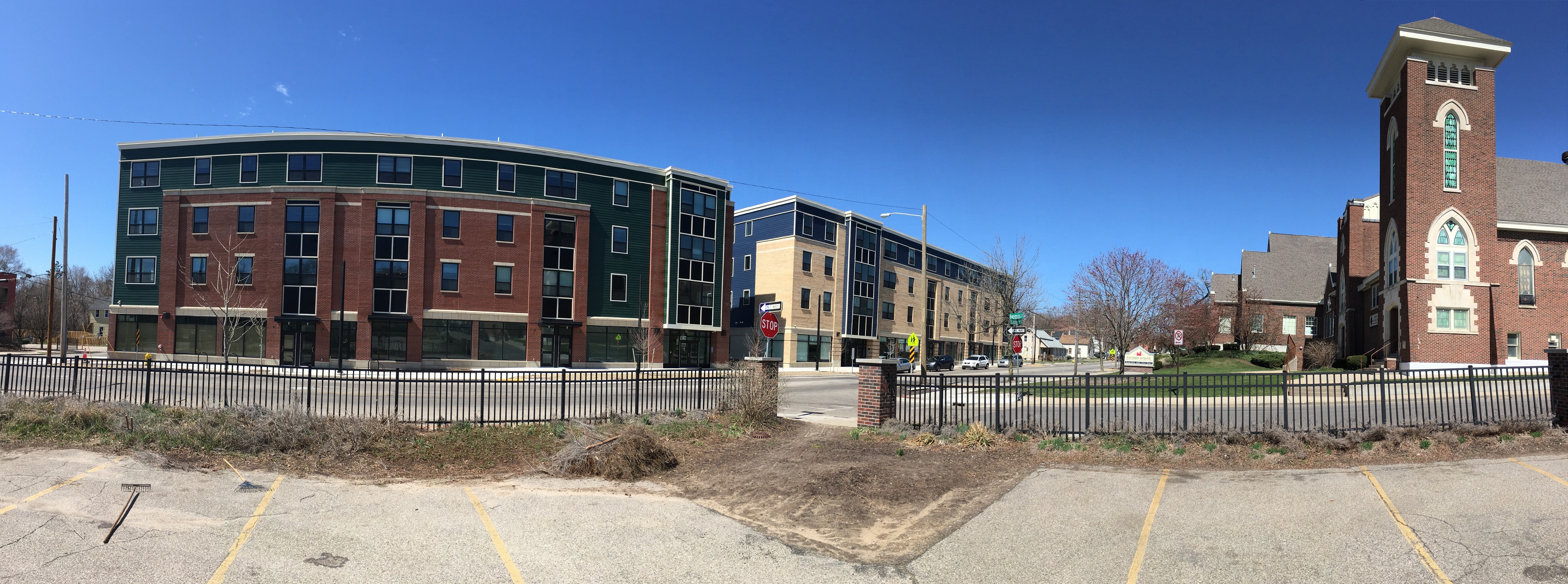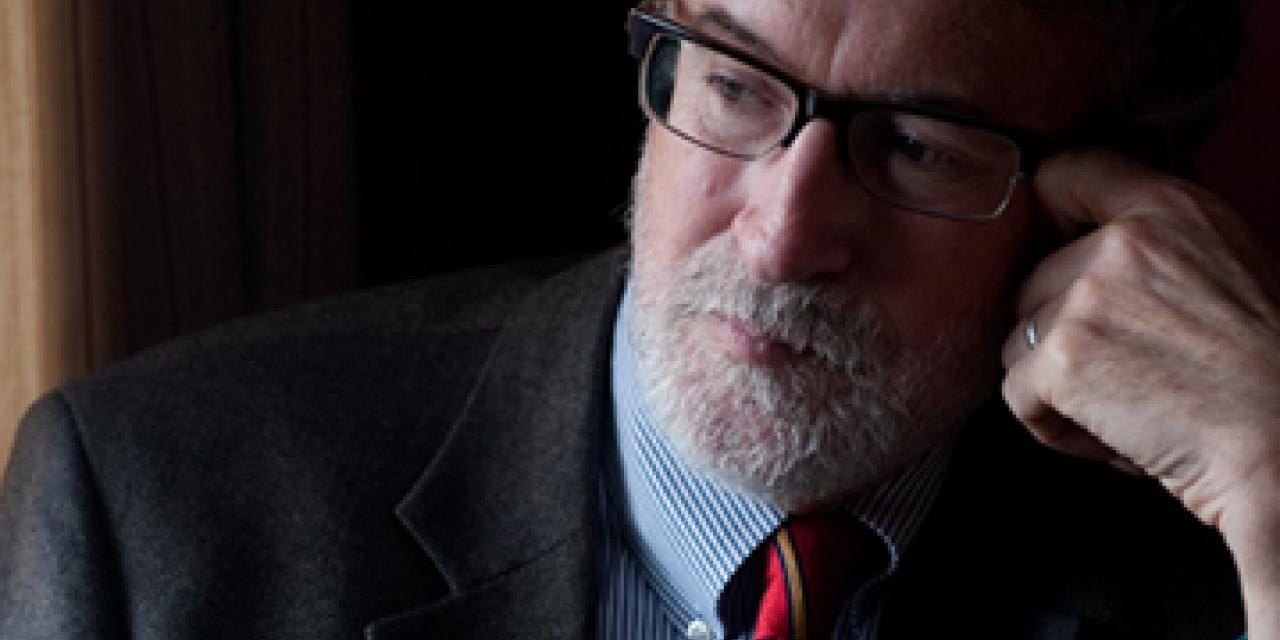Lee Hardy and his family joined Eastern Avenue Christian Reformed Church (EACRC) in the early 1980s, when he began teaching philosophy at what is now Calvin University in Grand Rapids, Michigan. Neglected, vandalized, and vacant buildings sat across Eastern Avenue from the church. The congregation reached out to its low-income neighborhood through the Saturday Food Program. Members renovated the former parsonage into housing for college students to provide a ministry of presence.
But every Sunday, worshipers looked out the historic church’s beautifully restored windows to urban blight. In 2006, Lee and Judy Hardy and 13 EACRC households formed Restoration Row LLC. “We planned to buy five individually owned properties and hand them off to a nonprofit to develop affordable housing across from our church. It was patient capital. We just wanted to break even. I thought it would take about five years,” Hardy recalls.
It was 14 years before Steepleview Apartments opened. All but four of the 65 apartments in the new buildings rent at less than market rate. Steepleview’s low- to moderate-income tenants include young adults who have aged out of foster care and residents who are incubating neighborhood businesses in six work/live units.
Restoration Row gradually acquired property, convinced Inner City Christian Federation (ICCF) to develop it, and waited for ICCF to receive low-income housing tax credits. Meanwhile, Hardy researched, taught, and wrote about new urbanism. And he used a 2019 Teacher-Scholar Grant from the Calvin Institute of Christian Worship to explore how congregations and faith-based nonprofits are tackling homelessness and housing insecurity. The result is a comprehensive website that also has liturgical resources for including housing ministry in worship.
Surprising abundance
The grant helped Hardy travel across North America and to the Netherlands to learn how communities of faith use their resources to support affordable housing. His website shares stories of how congregations identified their land, money, parking lots, time, building, and partners as abundant resources to shelter people.
“Most churches have a standing resource in willing volunteer labor, and most have a benevolence fund that could in part support affordable housing in their communities,” Hardy says. His website profiles two churches—Madison Church in Grand Rapids, Michigan, and Hughson Street Baptist Church in Hamilton, Ontario—whose building projects combine space for worship, affordable housing, and support services.
Hardy explains that finding land is a huge barrier for developing affordable housing, but that “some churches, especially in suburban and exurban locations, own land that could be used to that end.
“The Interfaith Alliance of Colorado recently conducted a study in a five-county area surrounding Denver. It discovered that churches in that area own over 5,000 acres of undeveloped land. The alliance partnered with Radian, a faith-based architectural and real estate development firm, to launch The Congregation Land Campaign. It helps churches envision how vacant land under their stewardship could be used to address local housing needs," Hardy says.
St. John’s Episcopal Church in Denver, Colorado, replaced part of its parking lot with apartments for unhoused people living with chronic disease, mental health challenges, or substance abuse. The new six-story building, Saint Francis Center, includes support staff offices, a resident community response manager, and beautiful common spaces.
First Congregational Church in Longmont, Colorado, reconfigured its parking area to make room for six micro-homes for people with very low incomes and high ages or disabilities. Discovery Christian Church has a 19-acre campus near Broomfield, a Denver suburb. It leased two acres for $1 a year so Habitat for Humanity could build four triplex units for low-income households.
Creative collaborations
Hardy’s experience with Steepleview Apartments showed him the staggering need for affordable housing and complexity of developing it. That’s why he advises faith communities to collaborate. Broad partnerships also help combat “not in my backyard” (NIMBY) pushback.
“There’s a 900-person waiting list for Steepleview. That shows how demand far outweighs the supply of affordable housing,” he says. A 2020 study showed that Grand Rapids needs nearly 9,000 more housing units by 2025, especially for people with low to moderate incomes.

Photo: Steepleview Apartments and Eastern Avenue Christian Reformed Church
Creating a successful affordable-housing project requires expertise in consulting neighbors, getting clear titles to property, navigating finances, vetting applicants, maintaining buildings, and more. Although few (if any) congregations have such expertise in affordable housing best practices, Hardy says that churches can be valuable partners in building community. “Steepleview has a community meeting room, childcare room, and ICCF staff member/resident who focuses on programming and mentorship,” he explains. “It’s not just apartments and hallways. Our church invites residents to join our streamed worship and pick up weekly food boxes. We look forward to when we can kick off in-person relationships with a big picnic.”
The website Hardy developed during his grant project shows how churches, clergy groups, denominational organizations, businesses, and nonprofits partnered to build tiny home villages in Denver and Detroit. The latter, Cass Community Tiny Homes, offers a “rent, then own” option to help formerly homeless people build generational wealth. Esperanza, founded by small Protestant Hispanic churches in Philadelphia, Pennsylvania, has strengthened its community through housing, the arts, education, economic development, and advocacy.
Sometimes people like the idea of more affordable housing—just not in their neighborhoods. “Those of us in the middle class would sometimes rather give money to a homeless shelter than welcome a low-income or mixed-income housing project, “ Hardy says. “It chips away at our privilege of living in an exclusive area. We tend to demonize cost-burdened renters as morally deficient. But we can learn from the long tradition of faith-based affordable housing in the Netherlands. We can join denominational or interfaith alliances such as YIGBY: Yes in God’s Back Yard to help make good projects happen.”
A 2020 study by the University of California–Berkeley mapped development potential on faith-based land in five Southern California counties. YIGBY’s home page notes: “San Diego County has 1,188 parcels zoned as religious use. The faith community holds over 4,675 acres of land, much of it already zoned for housing. Most can accommodate residential with no property tax.” Working together through YIGBY helps faith partners quickly scale up affordable housing through innovative projects such as converting unused shipping containers into housing.
The liturgical call to serve neighbors
Christian worship can help individuals and congregations see vulnerable unhoused people “for the first time and see Christ in them—for Christ clearly identified with the neighbor in need (Matthew 25),” Hardy says. He hired Sue A. Rozeboom, who teaches liturgical theology at Western Theological Seminary (WTS); Linnea Scobey, a WTS grad; and John Terpstra, a Canadian poet, to compile and write his website’s extensive worship resources.
“Churches can bring the needs of the homeless and the housing-insecure before the community of faith by way of lament, confession, and intercession. The website has prayers, songs and hymns, preaching texts, and liturgies for worship services and other occasions. Our church used these resources when we dedicated Steepleview and when we did a house blessing for a nearby house that we adopted through ICCF's Community Homes Initiative.
“The worship suggestions also work well if your church takes an offering for Habitat for Humanity or commissions people for a housing-related mission trip. Even if your faith community hasn’t yet gotten involved in affordable housing, you can use these ideas to raise awareness,” Hardy says.
The worship resources have a strong justice theme, he says, and the website includes advocacy advice because “I've learned that no true worship is acceptable to God without a commitment to justice. Communities of faith alive to the passion of God and the plight of the poor will see that a response to the current housing crisis is not just an optional external program of the church. It is central to living out the faith, where, as the Book of Common Prayer states, we ‘show forth your praise, not only with our lips, but in our lives.’”
LEARN MORE
Explore Lee Hardy’s affordable housing website for faith community stories and worship resources. Read his book The Embrace of Buildings: A Second Look at Walkable City Neighborhoods. Be sure to scroll down here to see fascinating photos related to that book. Learn about the Steepleview Apartments project.
The Afterword podcast, based in Greenville, SC, interviewed Lee Hardy and other experts for two podcast episodes. In the first episode, the panelists discuss suburban sprawl and urban development, and Hardy explains how he got interested in New Urbanism. In the second episode, the panelists explore the multifaceted aspects of urban renewal.
Watch short videos about repurposing a church parking lot (4:15) and shipping containers (7:22) into housing.
Reading “Home from Nowhere” in Atlantic Monthly in 1996 introduced Lee Hardy to the concept of New Urbanism, which promotes environmentally-friendly, walkable cities with a wide range of jobs, housing, and human diversity. He joined Congress for the New Urbanism (CNU) and is now the affordable housing contact for CNU's Christian Caucus.
Understand how federal low-income housing tax credits work in the US. The global pandemic has intensified housing insecurity for growing numbers of people, especially people of color, in Canada, the US, Europe, and throughout the world.
The nonprofit Community Solutions helps communities develop a process to solve homelessness. One essential step is to get better data by using a by-name list rather than depending on annual counts. Rockford, Illinois, and Abilene, Texas, have reached functional zero for homelessness.
START A DISCUSSION
Feel free to print and distribute this story to your staff, board, or education, social concerns, and worship committees. These questions will help people start a conversation about how your faith community can take a Matthew 25 approach to housing insecurity:
- Share a story about an experience that helped you see a vulnerable unhoused person as a brother or sister created in God’s image. How often are such stories or concerns included in your worship services?
- Which of your congregational resources might be used to address the affordable housing crisis? Which experts or groups might you partner with?
- Regional collaborations, such as Colorado Interfaith Alliance and YIGBY: Yes in God’s Back Yard, have conducted or used studies about land owned by faith communities. Who could help you do a similar project in your denominational district, city, county, or region?

